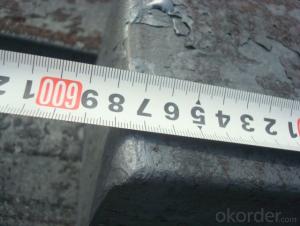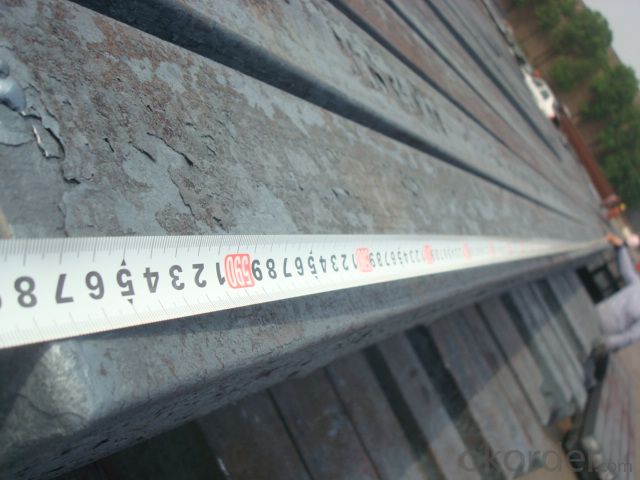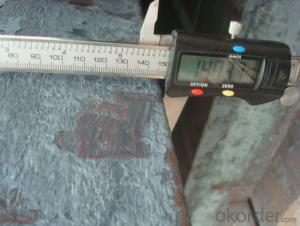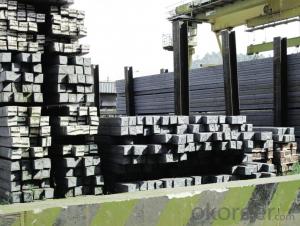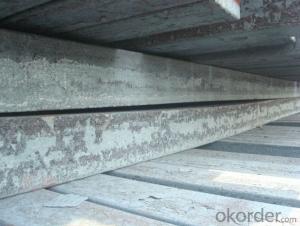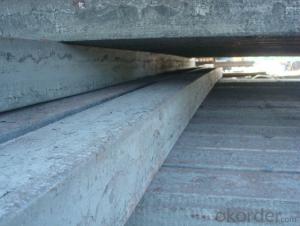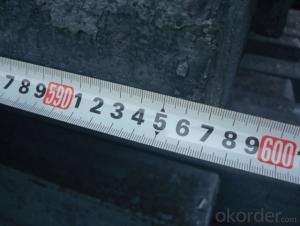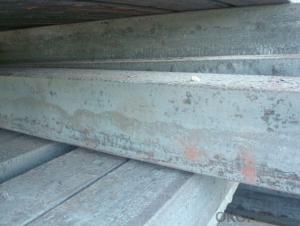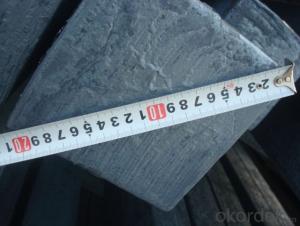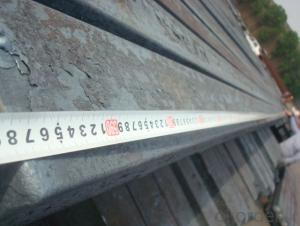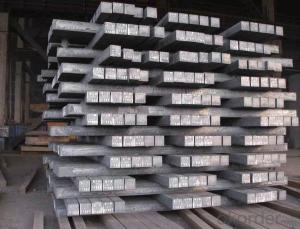Continue Casting Steel Bloom by Blasting Furnace
- Loading Port:
- Tianjin
- Payment Terms:
- TT OR LC
- Min Order Qty:
- 1000 m.t.
- Supply Capability:
- 100000 m.t./month
OKorder Service Pledge
OKorder Financial Service
You Might Also Like
Continue Casting Steel Bloom Manufactured by Blasting Furnace
1.Structure of Continue Casting Steel Bloom Manufactured by Blasting Furnace
Steel ingot by cogging or breakdown of semi-finished products, is the raw material of all kinds of steel mill.Billet section of square, round, flat, rectangular and abnormity, etcSeveral, mainly related to shape of rolled products.Simple rolled section steel, choose close to finished product cross section of square billet or rectangular billet.rollingThe sector products such as flat steel, Angle steel, select the rectangular billet or slab.Had better profiled billet when production beams, channels, and in rolling processLines and improve the yield.The raw material of round billet is the production of seamless tube.See billet production billet production methods. is the raw material of all kinds of steel mill.Billet section of square, round, flat, rectangular and abnormity, etcSeveral, mainly related to shape of rolled products.Simple rolled section steel, choose close to finished product cross section of square billet or rectangular billet.rollingThe sector products such as flat steel, Angle steel, select the rectangular billet or slab.Had better profiled billet when production beams, channels, and in rolling processLines and improve the yield.The raw material of round billet is the production of seamless tube.See billet production billet production methods.
2.Main Features of Continue Casting Steel Bloom Manufactured by Blasting Furnace.
Continue Casting Steel Bloom Manufactured by Blasting Furnace section size should meet the requirements of rolling deformation and finished product quality, but also roll strength and biting condition of restrictions. General steel Billet section height H. And the roll diameter D The ratio of the ( namely H/D) Should be less than or equal to zero 0.5 . Length of steel billet by finishing temperature, Rolling time and the length of the product Or times ruler. When heated too long accident prone to bump the furnace wall of steel, too short, furnace bottom utilization rate is not high, influence the heating furnace production. For the production Choose a variety of steel and steel billet, should consider the affinities of billet, as far as possible in order to improve the productivity of the roughing mill, simplify the stock management of workshop.
3. Continue Casting Steel Bloom Manufactured by Blasting Furnace Images
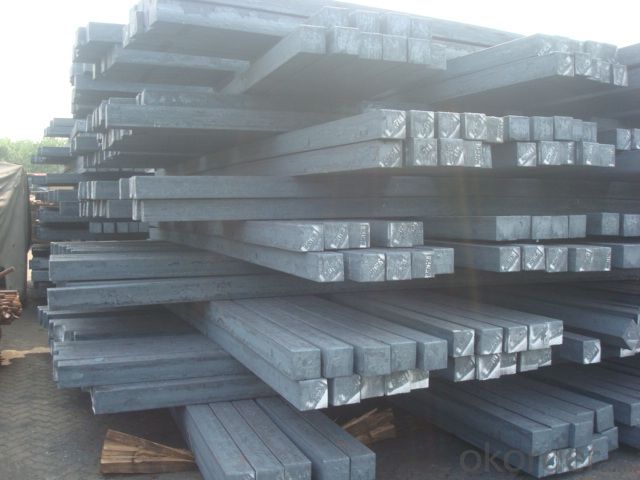

4. Continue Casting Steel Bloom Manufactured by Blasting Furnace Specification
1)SIZE
2)MATERIAL GRADE
3)CHEMICAL ELEMENTS COMPOSITONS
Material standard The editor Range of thickness: 150-240 - mm + / - 5 mm width range: 880-1530 - mm + / - 20 mm Length: 3700-10000 - mm + / - 500 - mm Cross-sectional size: 64 * 64; 82 * 82; 98 * 98; 124 * 124; 120 * 150; 152 * 164; 152 * 170 mm Length: 9000 mm Section of tolerance: billet: 1.0 + / - 2.0-1.0 + / - 1.0 mm slab: width: + / - 2.0 mm thickness: + / - 3.0 mm The length tolerance: + / - 200 mm Section diagonal tolerance: 3.5-8.0 MM Billet section size protrusions requirements: < 1242 mm, do not allow; > = 1242 mm, < = 2 mm 1242 mm, < = 3 mm Beheading (shear) extension deformation: < 1242 mm billet: no control; The slab: < = 15 mm Surface tilt: no more than billet section 0.1 Bending: every 1 m length is not more than 10 mm The distortion: length < = 5 m, < = 11. ; The length of the < = 7.5 M, < = 5. Material % 3 sp/PS chemical composition: C Mn Si S P
The classification of the billet Mainly from the shape is divided into two kinds: Slab: cross section width and height of the ratio of the larger, mainly used for rolling plate. Billet: equal cross section width and height, or a huge difference, mainly used for rolling steel, wire rod.
5.FAQ of Continue Casting Steel Bloom Manufactured by Blasting Furnace
We have organized several common questions for our clients,may help you sincerely:
①What kinds of the spec. of steel billet suitable to produce the section steel?
It is shade blank steel billet is better.
②Could we check the process of the producing in the steel mill?
Sure, but you must follow the instruction of the steel mills during the visiting. For safety consideration.
③How many days we should order before producing?
It depands on the detail order and situation of the steel mill, usually it is earlier, it is better.
- Q: What is the difference between steel billets and steel ingots?
- Steel billets and steel ingots, although both semi-finished steel products, differ in terms of their shape and manufacturing process. Rectangular or square-shaped bars, steel billets are typically produced through a continuous casting process. This process involves pouring molten steel into molds, allowing it to solidify into the desired shape. Billets are commonly used as raw material for further processing, such as rolling or forging, to create finished steel products like bars, rods, or wire. On the contrary, steel ingots are large, solid blocks of steel that are usually produced through a traditional casting process. In this process, molten steel is poured into large molds, left to cool and solidify. Ingots are mainly used for the production of larger steel components or as feedstock for forging or rolling operations. Prior to being processed into the final product, they are often remelted and refined. In terms of size, billets are generally smaller, with a cross-sectional area ranging from 36 to 155 square inches. On the other hand, ingots are larger, with a cross-sectional area exceeding 155 square inches. Both steel billets and steel ingots act as intermediary products in the steel manufacturing industry. The decision to use billets or ingots depends on the specific requirements of the final steel product and the manufacturing process involved.
- Q: How are steel billets used in the production of railway wheels?
- Steel billets are an indispensable element for manufacturing railway wheels. These billets, which are essentially semi-finished forms of steel, serve as the initial stage of the production process. To begin the production of railway wheels, the steel billets are subjected to high temperatures in a furnace. This heating process, known as hot rolling, enhances the steel's malleability and ductility, making it easier to shape. Once the billets have reached the desired temperature, they undergo a series of rolling operations. These operations gradually shape the billets into the required size and form for railway wheels. High pressure is applied to the billets during this rolling process, causing them to elongate and take on the desired shape. After the rolling process, the shaped billets undergo further processing to eliminate any excess material and refine the surface finish. This step ensures that the final product meets all the necessary specifications for railway wheels. Lastly, the shaped billets are sent for additional machining, where they are turned, drilled, and finished to create the final railway wheel. This machining process is essential in achieving the required dimensions, balance, and surface quality needed for safe and efficient operation. In conclusion, steel billets play a vital role in the production of railway wheels. They are heated, rolled, shaped, and further processed to create the essential components for the final product. Without steel billets, the production of railway wheels would not be feasible.
- Q: What is the role of steel billets in the production of wire rods?
- Steel billets play a crucial role in the production of wire rods. Wire rods are long, cylindrical metal rods that are commonly used in various industrial applications, such as construction, automotive, and manufacturing. The production process of wire rods begins with the melting of steel, which is typically done in an electric arc furnace or a basic oxygen furnace. Once the steel reaches the desired temperature and composition, it is poured into molds to form steel billets. Steel billets are semi-finished products that serve as the starting point for the wire rod manufacturing process. They are solid, rectangular or round bars of steel that undergo further processing to transform them into wire rods. The first step in the conversion of steel billets into wire rods is the reheating process. The billets are heated at a high temperature to make them more malleable and easier to work with. This is typically done in a reheat furnace. After reheating, the billets are passed through a series of rolling mills to reduce their size and shape them into wire rods. These rolling mills use a combination of pressure and heat to deform the steel billets and elongate them into long, thin rods. The process of rolling also helps to improve the mechanical properties of the wire rods, such as their strength and flexibility. Once the wire rods are formed, they may undergo additional treatments, such as cooling, surface treatments, and quality inspections, to meet the specific requirements of different applications. They can be further processed into various products, such as wires, cables, reinforcement bars, or other specialized components. In summary, steel billets are essential in the production of wire rods as they are the starting material that undergoes a series of processing steps, including reheating and rolling, to transform them into the desired shape and properties of wire rods.
- Q: How are steel billets used in the production of railway infrastructure?
- Steel billets are used in the production of railway infrastructure as they serve as the starting material for various components like rails, sleepers, and fasteners. These billets are heated and shaped into the required forms through processes like rolling or forging. Once formed, they are further processed and assembled to create durable and reliable railway tracks, bridges, and other structures, ensuring safe and efficient transportation.
- Q: What are the main factors affecting the surface finish of steel billets?
- Several key factors can be attributed to the surface finish of steel billets. Firstly, the quality and cleanliness of the raw materials used in the steelmaking process play a significant role. Surface defects and imperfections can occur if there are impurities or contaminants in the raw materials. Secondly, the manufacturing process's processing parameters directly impact the surface finish. Factors like temperature, speed, and pressure can affect the formation of scale, oxidation, and other surface abnormalities. Excessive scaling can result from high temperatures, while inadequate scale removal can occur due to insufficient temperature control. Furthermore, the surface finish of steel billets is influenced by the type and condition of the equipment used for production. Abrasions, scratches, or other defects in the machinery can transfer onto the billets, affecting their surface quality. Regular maintenance and proper upkeep of the machinery are crucial to ensure a smooth and defect-free surface finish. Moreover, the choice and application of lubricants and coatings during the production process also impact the surface finish. These substances protect the billets from oxidation and reduce friction. However, incorrect application or the use of the wrong lubricant can lead to uneven coating, streaking, or other surface irregularities. Lastly, the handling and storage of steel billets after production can affect their surface finish. Mishandling, improper storage conditions, or exposure to moisture, chemicals, or contaminants can all contribute to surface defects and deterioration. In conclusion, the surface finish of steel billets is influenced by the quality of raw materials, processing parameters, equipment condition, lubricant and coating application, and proper handling and storage. By closely monitoring and optimizing these factors, manufacturers can achieve a high-quality surface finish that meets the desired specifications and requirements.
- Q: Which is good for pure iron billet?
- If you would like to consult more detailed information, I suggest you choose Shanghai far west special steel products Co., ltd..
- Q: How are steel billets used in the manufacturing of pipes and tubes?
- Steel billets are a necessary component in the production of pipes and tubes. These billets, typically rectangular or square in shape, act as the starting point for the manufacturing process. Initially, they are heated to a high temperature to increase their malleability and facilitate shaping. After heating, the billets are passed through a sequence of rollers, gradually transforming them into a cylindrical shape. This hot rolling process refines the structure and enhances the mechanical properties of the steel. Moreover, it guarantees consistent dimensions throughout the length of the billet. Subsequently, the billets undergo further processing through cold rolling and sizing operations. Cold rolling reduces thickness and enhances the surface finish, while sizing operations ensure that the final product meets the necessary specifications in terms of diameter, wall thickness, and length. Once shaped and sized, the billets are cut into specific lengths and fused together to create seamless or welded pipes and tubes. Electric resistance welding (ERW), submerged arc welding (SAW), or other welding techniques are employed to join the ends of the billets. This results in a continuous and durable joint, ensuring the integrity and strength of the pipe or tube. The last phase of the manufacturing process involves various finishing operations, including heat treatment, straightening, and inspection. Heat treatment further improves the mechanical properties of the pipe or tube, while straightening guarantees a uniform shape without any deformations. Inspection is carried out to ensure that the pipes or tubes meet the required quality standards and specifications. In conclusion, steel billets play a vital role in the production of pipes and tubes. They undergo hot and cold rolling processes, are welded together, and subjected to finishing operations to create high-quality, dependable pipes and tubes.
- Q: What are the different types of defects that can occur in steel billets?
- There are several types of defects that can occur in steel billets, including surface cracks, internal voids, segregation, inclusions, and dimensional inconsistencies. These defects can affect the quality and structural integrity of the billets and may require further processing or remedial measures to ensure their suitability for use in various applications.
- Q: Can steel billets be extruded into different shapes?
- Yes, steel billets can be extruded into different shapes. Extrusion is a metalworking process where a material, in this case, a steel billet, is forced through a die to create a desired shape. The billet is heated to a specific temperature to make it malleable and then pushed through the die using a hydraulic or mechanical press. This process allows for the creation of a wide range of shapes, such as rods, bars, tubes, profiles, and even complex geometries. Extrusion is commonly used in the manufacturing industry to produce various steel products for construction, automotive, aerospace, and other applications.
- Q: What are the different international trade regulations for steel billets?
- There are several international trade regulations that govern the trade of steel billets. These regulations aim to promote fair trade practices, ensure product quality, and prevent unfair competition. Some of the key regulations for steel billets include: 1. Tariffs and duties: Many countries impose tariffs or import duties on steel billets to protect domestic steel industries. These tariffs can vary significantly between countries and may change periodically. Importers and exporters need to be aware of these tariffs and factor them into their pricing and cost calculations. 2. Anti-dumping measures: Anti-dumping regulations are in place to prevent the sale of steel billets in foreign markets at prices lower than their production cost, which can harm domestic industries. If a country determines that steel billets are being dumped into their market, they may impose anti-dumping duties or other measures to address the issue. 3. Trade agreements and trade barriers: International trade agreements, such as free trade agreements or regional trade blocs, can affect the trade of steel billets. These agreements may reduce or eliminate tariffs and other trade barriers between participating countries, promoting smoother trade flows. Conversely, countries not party to such agreements may face higher trade barriers, making it more challenging to export or import steel billets. 4. Quality and safety standards: Steel billets must meet specific quality and safety standards set by importing countries. These standards may include specifications for dimensions, chemical composition, mechanical properties, and other attributes. Importers and exporters need to ensure their steel billets comply with these standards to avoid rejection or additional inspection upon arrival. 5. Export controls: Some countries impose export controls or restrictions on certain goods, including steel billets, to ensure domestic supply or protect national security interests. These controls can limit the quantity or destination of steel billet exports, requiring exporters to obtain licenses or permits before shipping. 6. Documentation and customs requirements: International trade of steel billets requires proper documentation and adherence to customs procedures. Exporters must provide accurate and complete documentation, including commercial invoices, packing lists, certificates of origin, and other relevant documents. Importers must comply with customs requirements and pay any applicable duties or fees. It is essential for businesses involved in the trade of steel billets to stay informed about these international trade regulations. They should regularly monitor changes in tariffs, anti-dumping measures, trade agreements, and quality standards to ensure compliance and make informed business decisions.
Send your message to us
Continue Casting Steel Bloom by Blasting Furnace
- Loading Port:
- Tianjin
- Payment Terms:
- TT OR LC
- Min Order Qty:
- 1000 m.t.
- Supply Capability:
- 100000 m.t./month
OKorder Service Pledge
OKorder Financial Service
Similar products
Hot products
Hot Searches
Related keywords

